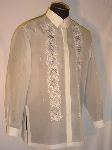FSA: One Unique Organization
Countdown to Our Next Event
Pinoy Joke of the Day
Philippine's National Symbols

PAMBANSANG LARO (NATIONAL GAME): SIPA

The game is both played on a large court surface inside an indoor or outdoor field (which is about the size of a modern day tennis court) by 2 teams that consists of 1, 2 or 4 players in each side. The aim of the game is to kick a soft ball made out of rattan fragments, back and forth over a high rise net placed in the middle of the court. The sport requires speed, agility and extremely good ball control.

PAMBANSANG SASAKYAN (NATIONAL VEHICLE): KALESA (HORSE-DRAWN CART)
This was one of the modes of transportation introduced in the Philippines in the 18th century. They are rarely used in the streets nowadays except in tourist spots and some rural areas. A kalesa looks like an inclined cart popularized during Spanish occupation as a method of transportation. It has two round wheels on each side and two rows of seats that can accommodate four persons. The driver sits in a block of wood hosted over the tip of the cart near the horse.
PAMBANSANG BAHAY (NATIONAL HOUSE): BAHAY KUBO (NIPA HUT)
The Nipa hut (bahay-kubo) is considered as the national house of the Philippines. It is, as the name implies, a hut, raised a few feet above the ground and constructed out of bamboo tied together, with a thatched roof using dried grass.
PAMBANSANG KASUOTAN NG LALAKE (NATIONAL MALE COSTUME):
BARONG TAGALOG
A Barong Tagalog (or simply Barong) is an embroidered formal garment of the Philippines. It is very lightweight and worn untucked (similar to a coat/dress shirt), over an undershirt. It is a common wedding and formal attire for Filipino men as well as women. They are usually made of Piña (pineapple) fibers, Jusi (from abaca or banana silk), Banana fabric, or a combination of Piña-Jusi fabric
PAMBANSANG KASUOTAN NG BABAE (NATIONAL FEMALE COSTUME):
BARO'T SAYA This indigenous mode of dressing of the natives of the Philippines was influenced during the Spanish Colonization of the archipelago. From the original, half-naked style, the bare upper torso was gradually covered with a short-sleeved, collarless blouse called "baro".[1] Some types of the national women's dress are the Maria Clara, having an alampay or pañuelo, a large kerchief wrapped around the shoulders, and the terno, having the butterfly sleeves popularized by former First Lady Imelda Marcos.
This indigenous mode of dressing of the natives of the Philippines was influenced during the Spanish Colonization of the archipelago. From the original, half-naked style, the bare upper torso was gradually covered with a short-sleeved, collarless blouse called "baro".[1] Some types of the national women's dress are the Maria Clara, having an alampay or pañuelo, a large kerchief wrapped around the shoulders, and the terno, having the butterfly sleeves popularized by former First Lady Imelda Marcos.
PAMBANSANG BAYANI (NATIONAL HERO): JOSE RIZAL
Dr. José P. Rizal (full name: José Protasio Rizal Mercado y Alonso Realonda) (June 19, 1861 – December 30, 1896) was a Filipino polymath, nationalist and the most prominent advocate for reforms in the Philippines during the Spanish colonial era. He is considered the Philippines' national hero and the anniversary of Rizal's death is commemorated as a Philippine holiday called Rizal Day. Rizal's 1896 military trial and execution made him a martyr of the Philippine Revolution.
PAMBANSANG IBON (NATIONAL BIRD): AGILA (PHILIPPINE EAGLE)
The Philippine Eagle (Pithecophaga jefferyi) is one of the tallest, rarest, largest and most powerful birds in the world. This bird of prey, or raptor, belongs to the family Accipitridae. It is also known as "Haribon" or "Haring Ibon," meaning "Bird King." Its local name is banog
PAMBANSANG SAYAW (NATIONAL DANCE): KARINYOSA/CARINOSA
Cariñosa (IPA: [ˌkariˈɲosa]) (meaning the loving or affectionate one in Spanish) is a Philippine group dance of Hispanic origin from the Maria Clara suite of Philippine folk dances, where the fanhandkerchief plays an instrumental role as it places the couple in a hard-to-get romance scenario. Despite popular belief, Cariñosa has always been the national dance of the Philippines, whereas the Tinikling is just a worldwide favorite.
PAMBANSANG HAYOP (NATIONAL ANIMAL): KALABAW (CARABAO)
PAMBANSANG PUNO (NATIONAL TREE): NARRA TREE
PAMBANSANG PAN-SAPIN SA PAA (NATIONAL SLIPPERS): BAKYA
PAMBANSANG DAHON (NATIONAL LEAF): ANAHAW
PAMBANSANG ISDA (NATIONAL FISH): BANGUS (MILKFISH)
PAMBANSANG PAGKAIN (NATIONAL FOOD): LITSON/LECHON Lechón (Tagalog: Litson and Cebuano: Inasal) is the Spanish word for suckling pig. In the Philippines, it connotes a whole roasted pig, lechón baboy. Chicken and beef are also popular. The process of lechón involves the whole pig/piglet, chicken, or cattle/calf being slowly roasted over charcoal.
Lechón (Tagalog: Litson and Cebuano: Inasal) is the Spanish word for suckling pig. In the Philippines, it connotes a whole roasted pig, lechón baboy. Chicken and beef are also popular. The process of lechón involves the whole pig/piglet, chicken, or cattle/calf being slowly roasted over charcoal.
PAMBANSANG WATAWAT (NATIONAL FLAG)
The national flag of the Philippines is a horizontal bicolor with equal bands of blue and red, and with a white equilateral triangle based at the hoist side; in the center of the triangle is a golden yellow sun with eight primary rays, each containing three individual rays; and at each corner of the triangle is a five-pointed golden yellow star. The three stars represent the 3 main islands of the Philippines: Luzon, Visayas and Mindanao. The flag is displayed with the blue field on top in times of peace, and with the red field on top in times of war.
PAMABNSANG WIKA (NATIONAL LANGUAGE): FILIPINO/TAGALOG
10:25 PM
|
Labels:
National symbols
|
About Us

- Filipino Student Association - SLU
- Saint Louis, Missouri, United States
- Dedicated to promoting unity within the organization through awareness of the beauty and magnificence of the Filipino culture.

0 comments:
Post a Comment